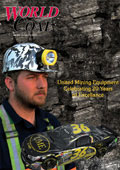Editorial comment
The regional report this month takes a different approach to usual, focusing not on a single geography but on a theme: exploring coal’s new frontiers. In three articles, we explore the potential of the coal industries of three emerging markets: Mongolia, Mozambique and Sumatra and Central Kalimantan in Indonesia. A fourth article, from Dr Elizabeth Stephens of JLT Specialty, then considers the inherent challenges in developing projects in such frontier environments.
Register for free »
Get started now for absolutely FREE, no credit card required.
Reading these articles, it becomes clear that the developers of coal mining projects face similar challenges regardless of where they are located. In her article (pp. 41 – 45), Dr Stephens identifies two broad themes: political uncertainty and infrastructure.
Political uncertainty can take a range of forms. In Mongolia and Indonesia, resources nationalism has created an uncertain investment environment for foreign investors. Writing on the potential for developing a coal export industry in Sumatra (pp. 32 – 40), Dr Lars Schernikau and Daniel Goeckus make the point that, despite much potential, “large-scale investments are still not on the horizon […] because of Indonesia’s continued discussion about banning low grade coal exports.” Meanwhile, Dr Andrew Minchiner writes (pp. 27 – 31) that investment in the Mongolian coal industry is now seen as “overtly risky” after various government pronouncements muddied what had been seen as a relatively stable investment environment.
In Mozambique, infrastructure is the main hold up. In his article (pp. 22 – 26), Barry Baxter, notes that both Rio Tinto and Vale have had to rethink their investment in the country, “largely on infrastructure shortcomings.” Here as well, politics can play a role: Dr Stephens notes speculation that the Mozambican government stymied infrastructure projects of benefit to Rio Tinto as a penalty for “being perceived to have avoided capital gains taxes in 2011.” While in Mongolia, the government is trapped between its two giant neighbours – Russia and China – as it tries to balance the need to get its coal to markets with a desire to remain independent of outside influence.
These challenges may appear to be problems of emerging markets – but they are echoed even in the most developed of economies. As Anthony Fensom reported for World Coal last month, the Minerals Council of Australia estimates that Australian miners have faced a doubling of green and red tape since 2006. In the US, miners face regulatory uncertainty after a federal court ruled the US Environmental Protection Agency had the authority to void environmental permits that had already been approved. Commenting on the ruling, Hal Quinn, CEO of the National Mining Association, noted that: “companies will no longer have the assurance required to encourage investments, grow our economy and create jobs.” Meanwhile, coal companies aiming to export US coal to Asia face a battle with environmental groups to develop the necessary port infrastructure.
These are the endemic challenges to which the coal industry will need to find solutions if it is to develop. But it is an industry that is not unused to such pressure: an industry that, despite inhospitable terrain and unpredictable politicians, still provides the fuel that keeps billions of people’s lights on around the world. I wouldn’t bet against it.


